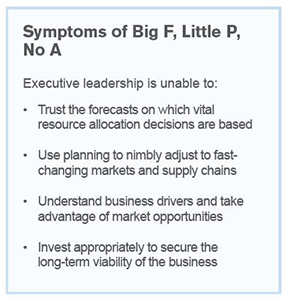
In most companies, the financial component of FP&A has clearly-defined processes and roles. Although the process varies from company to company, each will have regular and repeatable processes by which to accommodate tasks, responsibilities, and deliverables.
But what about the other attributes of “FP&A”? Has your organization established a repeatable process and expectation for using planning and analysis on a regular basis? According to the recent Financial Executive Article, CFOs Need Fresh Perspective, chances are the answer is very likely to be, “No.”
It is surprising to learn (from recent research) that 41% of organizations feel the need to review their long-range plan monthly. This response overtly identifies a business function that either needs so much inspection it requires explicit attention or the process is wrought with inefficiencies that resources are being wasted.

In the new white paper, Big F, Little P, and No A, FP&A expert and consultant, Madison Laird, contends that while it may be typical for FP&A to function as “mostly Finance, limited Planning, and zero Analysis,” those charged with FP&A should demand more tools and higher expectations of their calling. Specifically, he writes that since Finance owns the budget throughout the year:
“Finance is usually asked to support the decision-making process, which rebalances the portfolio and results in budget reallocations. Supporting this reallocation requires analytical capabilities, which provide a link back to the goals of the original long-range plan. This analytical bridge inspires confidence amount constituents of the plan and it requires that Finance make a concerted effort to provide this level of planning support and analytical insight on an ongoing basis.”
Among more specific recommendations, Laird contends that the objective for any FP&A organization is to achieve better Planning through improved efficiency and to enhance Analysis by having access to reliable, timely, and accurate data which will, in turn, increase confidence and churn out repeatable processes and expectations.
Having read the analysis of both articles, the reasoning is rather clear: If planning and analysis is as important as the FP&A title implies, embracing the mantra to improve efficiency and strive for confidence in your data is pretty good advice for curing this very common finance problem.
Would you like to read more?
- Download the free white paper, Big F, Little A, and No P, by Madison Laird.
- Read the article, CFOs Need Fresh Perspective on Long-Range Planning, by Rich Murphy in Financial Executive Magazine.




